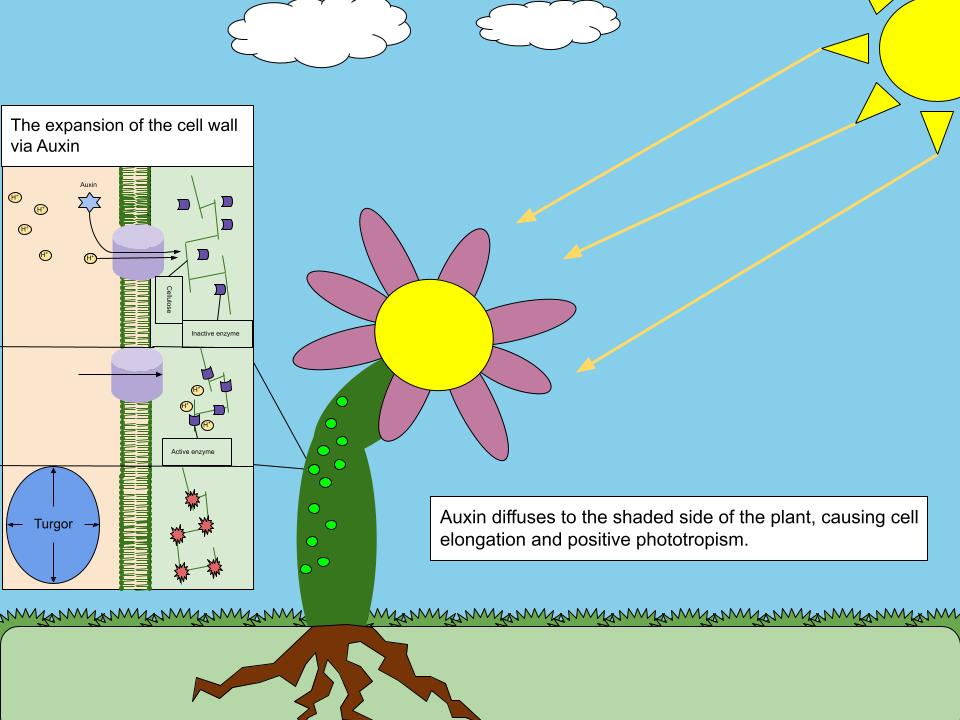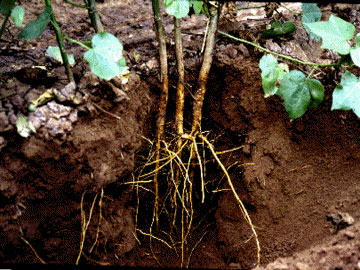|
Gravitropism
Gravitropism (also known as geotropism) is a coordinated process of differential growth by a plant in response to gravity pulling on it. It also occurs in fungi. Gravity can be either "artificial gravity" or natural gravity. It is a general feature of all higher and many lower plants as well as other organisms. Charles Darwin was one of the first to scientifically document that roots show ''positive gravitropism'' and stems show ''negative gravitropism''. That is, roots grow in the direction of gravitational pull (i.e., downward) and stems grow in the opposite direction (i.e., upwards). This behavior can be easily demonstrated with any potted plant. When laid onto its side, the growing parts of the stem begin to display negative gravitropism, growing (biologists say, turning; see tropism) upwards. Herbaceous (non-woody) stems are capable of a degree of actual bending, but most of the redirected movement occurs as a consequence of root or stem growth outside. The mechanism is ... [...More Info...] [...Related Items...] OR: [Wikipedia] [Google] [Baidu] |
Cholodny–Went Model
In botany, the Cholodny–Went model, proposed in 1927, is an early model describing tropism in emerging shoots of monocotyledons, including the tendencies for the shoot to grow towards the light ( phototropism) and the roots to grow downward (gravitropism). In both cases the directional growth is considered to be due to asymmetrical distribution of auxin, a plant growth hormone. Although the model has been criticized and continues to be refined, it has largely stood the test of time. Basic model The model was independently proposed by the Russian-born scientist Nikolai Cholodny of the University of Kyiv, Ukraine, in 1927 and by Frits Warmolt Went of the California Institute of Technology in 1928, both based on work they had done in 1926. The basic elements of the theory are that auxin is the sole hormone that controls growth in gravitropism and phototropism; the rate of growth depends on the concentration of auxin; and both gravity and unidirectional light affect the movemen ... [...More Info...] [...Related Items...] OR: [Wikipedia] [Google] [Baidu] |
Auxin
Auxins (plural of auxin ) are a class of plant hormones (or plant-growth regulators) with some morphogen-like characteristics. Auxins play a cardinal role in coordination of many growth and behavioral processes in plant life cycles and are essential for plant body development. The Dutch biologist Frits Warmolt Went first described auxins and their role in plant growth in the 1920s. Kenneth V. Thimann became the first to isolate one of these phytohormones and to determine its chemical structure as indole-3-acetic acid (IAA). Went and Thimann co-authored a book on plant hormones, ''Phytohormones'', in 1937. Overview Auxins were the first of the major plant hormones to be discovered. They derive their name from the Greek word ( – 'to grow/increase'). Auxin is present in all parts of a plant, although in very different concentrations. The concentration in each position is crucial developmental information, so it is subject to tight regulation through both metabolism and transp ... [...More Info...] [...Related Items...] OR: [Wikipedia] [Google] [Baidu] |
Amyloplasts
Amyloplasts are a type of plastid, double-enveloped organelles in plant cells that are involved in various biological pathways. Amyloplasts are specifically a type of leucoplast, a subcategory for colorless, non-pigment-containing plastids. Amyloplasts are found in roots and storage tissues, and they store and synthesize starch for the plant through the polymerization of glucose. Starch synthesis relies on the transportation of carbon from the cytosol, the mechanism by which is currently under debate. Starch synthesis and storage also takes place in chloroplasts, a type of pigmented plastid involved in photosynthesis. Amyloplasts and chloroplasts are closely related, and amyloplasts can turn into chloroplasts; this is for instance observed when potato tubers are exposed to light and turn green. Role in gravity sensing Amyloplasts are thought to play a vital role in gravitropism. Statoliths, a specialized starch-accumulating amyloplast, are denser than cytoplasm, and are able to s ... [...More Info...] [...Related Items...] OR: [Wikipedia] [Google] [Baidu] |
Root
In vascular plants, the roots are the plant organ, organs of a plant that are modified to provide anchorage for the plant and take in water and nutrients into the plant body, which allows plants to grow taller and faster. They are most often below the surface of the soil, but roots can also be aerial root, aerial or aerating, that is, growing up above the ground or especially above water. Function The major functions of roots are absorption of water, plant nutrition and anchoring of the plant body to the ground. Types of Roots (major rooting system) Plants exhibit two main root system types: ''taproot'' and ''fibrous'', with variations like adventitious, aerial, and buttress roots, each serving specific functions. Taproot System Characterized by a single, main root growing vertically downward, with smaller lateral roots branching off. Examples. Dandelions, carrots, and many dicot plants. Fibrous RootSystem Consists of a network of thin, branching roots that spread out from ... [...More Info...] [...Related Items...] OR: [Wikipedia] [Google] [Baidu] |
Phytochrome
Phytochromes are a class of photoreceptor proteins found in plants, bacteria and fungi. They respond to light in the red and far-red regions of the visible spectrum and can be classed as either Type I, which are activated by far-red light, or Type II that are activated by red light. Recent advances have suggested that phytochromes also act as temperature sensors, as warmer temperatures enhance their de-activation. All of these factors contribute to the plant's ability to germinate. Phytochromes control many aspects of plant development. They regulate the germination of seeds (photoblasty), the synthesis of chlorophyll, the elongation of seedlings, the size, shape and number and movement of leaves and the timing of flowering in adult plants. Phytochromes are widely expressed across many tissues and developmental stages. Other plant photoreceptors include cryptochromes and phototropins, which respond to blue and ultraviolet-A light and UVR8, which is sensitive to ultraviol ... [...More Info...] [...Related Items...] OR: [Wikipedia] [Google] [Baidu] |
Tropism
In biology, a tropism is a phenomenon indicating the growth or turning movement of an organism, usually a plant, in response to an environmental stimulus (physiology), stimulus. In tropisms, this response is dependent on the direction of the stimulus (as opposed to nastic movements, which are non-directional responses). Tropisms are usually named for the stimulus involved; for example, a phototropism is a movement to the light source, and an anemotropism is the response and adaptation of plants to the wind. Tropisms occur in three sequential steps. First, there is a sensation to a stimulus. Next, signal transduction occurs. And finally, the directional growth response occurs. Tropisms can be regarded by Ethology, ethologists as ''taxis'' (directional response) or ''kinesis (biology), kinesis'' (non-directional response). The Cholodny–Went model, proposed in 1927, is an early model describing tropism in emerging shoots of monocotyledons, including the tendencies for the st ... [...More Info...] [...Related Items...] OR: [Wikipedia] [Google] [Baidu] |
Phototropism
In biology, phototropism is the growth of an organism in response to a light stimulus. Phototropism is most often observed in plants, but can also occur in other organisms such as fungi. The cells on the plant that are farthest from the light contain a hormone called auxin that reacts when phototropism occurs. This causes the plant to have elongated cells on the furthest side from the light. Phototropism is one of the many plant tropisms, or movements, which respond to external stimuli. Growth towards a light source is called positive phototropism, while growth away from light is called negative phototropism. Negative phototropism is not to be confused with skototropism, which is defined as the growth towards darkness, whereas negative phototropism can refer to either the growth away from a light source or towards the darkness. Most plant shoots exhibit positive phototropism, and rearrange their chloroplasts in the leaves to maximize photosynthetic energy and promote growth.G ... [...More Info...] [...Related Items...] OR: [Wikipedia] [Google] [Baidu] |
Plant Hormone
Plant hormones (or phytohormones) are signal molecules, produced within plants, that occur in extremely low concentrations. Plant hormones control all aspects of plant growth and development, including embryogenesis, the regulation of Organ (anatomy), organ size, pathogen defense, Stress (biology), stress tolerance and Reproduction, reproductive development. Unlike in animals (in which hormone production is restricted to specialized glands) each plant cell is capable of producing hormones. Frits Warmolt Went, Went and Thimann coined the term "phytohormone" and used it in the title of their 1937 book. Phytohormones occur across the plant kingdom, and even in algae, where they have similar functions to those seen in vascular plant, vascular plants ("higher plants"). Some phytohormones also occur in microorganisms, such as unicellular fungus, fungi and bacteria, however in these cases they do not play a hormonal role and can better be regarded as secondary metabolites. Characteristi ... [...More Info...] [...Related Items...] OR: [Wikipedia] [Google] [Baidu] |




